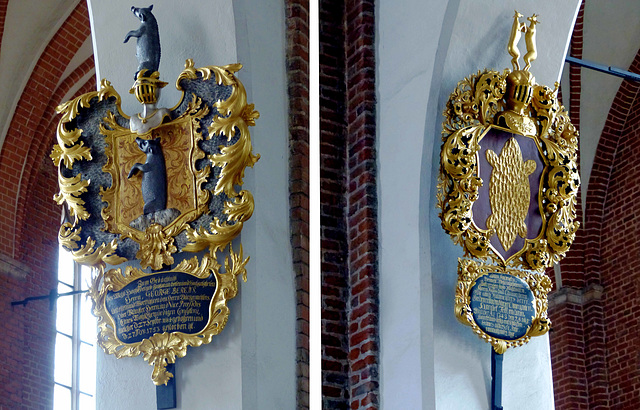Location
Lat, Lng: 56.947526, 24.108984
You can copy the above to your favourite mapping app.
Address: Pēterbaznīca
You can copy the above to your favourite mapping app.
Address: Pēterbaznīca
See also...
Keywords
Authorizations, license
-
Visible by: Everyone -
All rights reserved
-
74 visits
Riga - Svētā Pētera baznīca


Riga is the capital of Latvia. With a population of more than 600.000 about a third of all Latvians live here. A settlement of the Finno-Ugric Livs existed on the bank of the Düna. At the end of the 12th century, merchants from Gotland came to trade here.
Albert von Buxthoeven, a fierce missionary, was the first bishop in Riga from 1201 to 1229. Riga developed as the hub of Russian trade and the starting point of the German colonization of the Baltic.
The merchants who settled here after the subjugation of the surrounding peoples rapidly gained influence. In 1225, they were able to elect the city bailiff themselves, when the City Council existed already.
After the Reformation, the power of the archbishops came to an end. After the outbreak of the Livonian War in 1558 the city favoured the status of a free imperial city of the Holy Roman Empire. It was only when the imperial support failed to materialize that the renewed advance of Russian armies led the city to pay homage to Poland's King Stephen Báthory in 1581, who in return confirmed the city's traditional freedoms and privileges.
The 40-year Polish-Lithuanian rule, under which the citizens of Riga successfully resisted anti-Reformation efforts ended with the conquest of the city by Gustav II Adolf of Sweden in 1621. The Swedish crown treated Riga by its rank as the second-largest city in the kingdom and had it lavishly fortified. During the Russo-Swedish War (1656-1658), Riga withstood the Russian siege and maintained its position as one of the most important cities in Sweden until the beginning of the 18th century. During this period the city enjoyed extensive self-government.
The Svētā Pētera baznīca (St. Peter´s church) was first mentioned in 1209 and served as a place of worship and meeting place for the community, consisting of Hanseatic merchants and the craftsmen's guilds. The oldest preserved parts today are in the high choir. This area was enlarged to 30 meters in height between 1406 and 1409 according to the taste of the time. The citizens were in constant dispute with the Riga archbishops over the exercise of power in the city. This had an influence on this church reconstruction, for political reasons the building work had to be stopped until 1456. It was not until 1473 that the chancel could be completed. In competition with the cathedral, the seat of the archbishop, a far more magnificent church was to be built here. The further expansion of St. Peter's Church was completed with the tower in 1491.
On the walls the baroque coats of arms of local nobles. Here are two of them.
Albert von Buxthoeven, a fierce missionary, was the first bishop in Riga from 1201 to 1229. Riga developed as the hub of Russian trade and the starting point of the German colonization of the Baltic.
The merchants who settled here after the subjugation of the surrounding peoples rapidly gained influence. In 1225, they were able to elect the city bailiff themselves, when the City Council existed already.
After the Reformation, the power of the archbishops came to an end. After the outbreak of the Livonian War in 1558 the city favoured the status of a free imperial city of the Holy Roman Empire. It was only when the imperial support failed to materialize that the renewed advance of Russian armies led the city to pay homage to Poland's King Stephen Báthory in 1581, who in return confirmed the city's traditional freedoms and privileges.
The 40-year Polish-Lithuanian rule, under which the citizens of Riga successfully resisted anti-Reformation efforts ended with the conquest of the city by Gustav II Adolf of Sweden in 1621. The Swedish crown treated Riga by its rank as the second-largest city in the kingdom and had it lavishly fortified. During the Russo-Swedish War (1656-1658), Riga withstood the Russian siege and maintained its position as one of the most important cities in Sweden until the beginning of the 18th century. During this period the city enjoyed extensive self-government.
The Svētā Pētera baznīca (St. Peter´s church) was first mentioned in 1209 and served as a place of worship and meeting place for the community, consisting of Hanseatic merchants and the craftsmen's guilds. The oldest preserved parts today are in the high choir. This area was enlarged to 30 meters in height between 1406 and 1409 according to the taste of the time. The citizens were in constant dispute with the Riga archbishops over the exercise of power in the city. This had an influence on this church reconstruction, for political reasons the building work had to be stopped until 1456. It was not until 1473 that the chancel could be completed. In competition with the cathedral, the seat of the archbishop, a far more magnificent church was to be built here. The further expansion of St. Peter's Church was completed with the tower in 1491.
On the walls the baroque coats of arms of local nobles. Here are two of them.
- Keyboard shortcuts:
Jump to top
RSS feed- Latest comments - Subscribe to the comment feeds of this photo
- ipernity © 2007-2025
- Help & Contact
|
Club news
|
About ipernity
|
History |
ipernity Club & Prices |
Guide of good conduct
Donate | Group guidelines | Privacy policy | Terms of use | Statutes | In memoria -
Facebook
Twitter











Sign-in to write a comment.